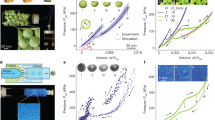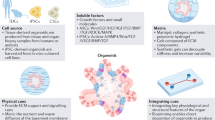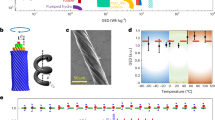Abstract
Pacemaker cells can be differentiated from stem cells or transdifferentiated from quiescent mature cardiac cells via genetic manipulation. Here we show that the exposure of rat quiescent ventricular cardiomyocytes to a silk-fibroin hydrogel activates the direct conversion of the quiescent cardiomyocytes to pacemaker cardiomyocytes by inducing the ectopic expression of the vascular endothelial cell-adhesion glycoprotein cadherin. The silk-fibroin-induced pacemaker cells exhibited functional and morphological features of genuine sinoatrial-node cardiomyocytes in vitro, and pacemaker cells generated via the injection of silk fibroin in the left ventricles of rats functioned as a surrogate in situ sinoatrial node. Biomaterials with suitable surface structure, mechanics and biochemistry could facilitate the scalable production of biological pacemakers for human use.
This is a preview of subscription content, access via your institution
Access options
Access Nature and 54 other Nature Portfolio journals
Get Nature+, our best-value online-access subscription
$29.99 / 30 days
cancel any time
Subscribe to this journal
Receive 12 digital issues and online access to articles
$99.00 per year
only $8.25 per issue
Buy this article
- Purchase on Springer Link
- Instant access to full article PDF
Prices may be subject to local taxes which are calculated during checkout







Similar content being viewed by others
Data availability
The main data supporting the results in this study are available within the paper and its Supplementary Information. The analysed datasets generated during the study are too large to be all publicly shared. A subset of the data, including source data and the data used to make the figures, are available from figshare with the identifier https://doi.org/10.6084/m9.figshare.14198261. More data are also available for research purposes from the corresponding authors on reasonable request. The dataset of the whole-transcriptome analysis (Fig. 4a) is available from the Sequence Read Archive (SRA) via the accession code PRJNA691697.
References
Epstein, A. E. et al. 2012 ACCF/AHA/HRS focused update incorporated into the ACCF/AHA/HRS 2008 guidelines for device-based therapy of cardiac rhythm abnormalities: a report of the American College of Cardiology Foundation/American Heart Association Task Force on Practice Guidelines and the Heart Rhythm Society. Circulation 127, e283–e352 (2013).
Cingolani, E., Goldhaber, J. I. & Marban, E. Next-generation pacemakers: from small devices to biological pacemakers. Nat. Rev. Cardiol. 15, 139–150 (2018).
Protze, S. I. et al. Sinoatrial node cardiomyocytes derived from human pluripotent cells function as a biological pacemaker. Nat. Biotechnol. 35, 56–68 (2017).
Kapoor, N., Liang, W., Marban, E. & Cho, H. C. Direct conversion of quiescent cardiomyocytes to pacemaker cells by expression of Tbx18. Nat. Biotechnol. 31, 54–62 (2013).
Hu, Y. F., Dawkins, J. F., Cho, H. C., Marban, E. & Cingolani, E. Biological pacemaker created by minimally invasive somatic reprogramming in pigs with complete heart block. Sci. Transl. Med. 6, 245ra94 (2014).
Munshi, N. V. & Olson, E. N. Translational medicine. Improving cardiac rhythm with a biological pacemaker. Science 345, 268–269 (2014).
Fox, I. J. et al. Stem cell therapy. Use of differentiated pluripotent stem cells as replacement therapy for treating disease. Science 345, 1247391 (2014).
Bongianino, R. & Priori, S. G. Gene therapy to treat cardiac arrhythmias. Nat. Rev. Cardiol. 12, 531–546 (2015).
Rosen, M. R. Gene therapy and biological pacing. N. Engl. J. Med. 371, 1158–1159 (2014).
Hou, P. et al. Pluripotent stem cells induced from mouse somatic cells by small-molecule compounds. Science 341, 651–654 (2013).
Paoletti, C., Divieto, C. & Chiono, V. Impact of biomaterials on differentiation and reprogramming approaches for the generation of functional cardiomyocytes. Cells 7, 114 (2018).
Yang, M. C. et al. The cardiomyogenic differentiation of rat mesenchymal stem cells on silk fibroin-polysaccharide cardiac patches in vitro. Biomaterials 30, 3757–3765 (2009).
Chopra, A. et al. Reprogramming cardiomyocyte mechanosensing by crosstalk between integrins and hyaluronic acid receptors. J. Biomech. 45, 824–831 (2012).
Li, Y. et al. Tissue-engineered 3-dimensional (3D) microenvironment enhances the direct reprogramming of fibroblasts into cardiomyocytes by microRNAs. Sci. Rep. 6, 38815 (2016).
Smith, A. W. et al. Direct reprogramming of mouse fibroblasts to cardiomyocyte-like cells using Yamanaka factors on engineered poly(ethylene glycol) (PEG) hydrogels. Biomaterials 34, 6559–6571 (2013).
Shinagawa, Y., Satoh, H. & Noma, A. The sustained inward current and inward rectifier K+ current in pacemaker cells dissociated from rat sinoatrial node. J. Physiol. 523, 593–605 (2000).
DiFrancesco, D. The role of the funny current in pacemaker activity. Circ. Res. 106, 434–446 (2010).
Maltsev, V. A. & Lakatta, E. G. Dynamic interactions of an intracellular Ca2+ clock and membrane ion channel clock underlie robust initiation and regulation of cardiac pacemaker function. Cardiovasc. Res. 77, 274–284 (2008).
Lakatta, E. G., Maltsev, V. A. & Vinogradova, T. M. A coupled SYSTEM of intracellular Ca2+ clocks and surface membrane voltage clocks controls the timekeeping mechanism of the heart’s pacemaker. Circ. Res. 106, 659–673 (2010).
Vinogradova, T. M. et al. High basal protein kinase A-dependent phosphorylation drives rhythmic internal Ca2+ store oscillations and spontaneous beating of cardiac pacemaker cells. Circ. Res. 98, 505–514 (2006).
Boyett, M. R. et al. Sophisticated architecture is required for the sinoatrial node to perform its normal pacemaker function. J. Cardiovasc. Electrophysiol. 14, 104–106 (2003).
ten Velde, I. et al. Spatial distribution of connexin43, the major cardiac gap junction protein, visualizes the cellular network for impulse propagation from sinoatrial node to atrium. Circ. Res. 76, 802–811 (1995).
Verheijck, E. E. et al. Electrophysiological features of the mouse sinoatrial node in relation to connexin distribution. Cardiovasc. Res. 52, 40–50 (2001).
Wang, W. E. et al. Dedifferentiation, proliferation, and redifferentiation of adult mammalian cardiomyocytes after ischemic injury. Circulation 136, 834–848 (2017).
D’Uva, G. et al. ERBB2 triggers mammalian heart regeneration by promoting cardiomyocyte dedifferentiation and proliferation. Nat. Cell Biol. 17, 627–638 (2015).
Jopling, C. et al. Zebrafish heart regeneration occurs by cardiomyocyte dedifferentiation and proliferation. Nature 464, 606–609 (2010).
Chen, X. et al. Single-cell transcriptome and epigenomic reprogramming of cardiomyocyte-derived cardiac progenitor cells. Sci. Data 3, 160079 (2016).
Guo, M., Breslin, J. W., Wu, M. H., Gottardi, C. J. & Yuan, S. Y. VE-cadherin and beta-catenin binding dynamics during histamine-induced endothelial hyperpermeability. Am. J. Physiol. Cell Physiol. 294, C977–C984 (2008).
Lagendijk, A. K. et al. Live imaging molecular changes in junctional tension upon VE-cadherin in zebrafish. Nat. Commun. 8, 1402 (2017).
Gottardi, C. J. & Gumbiner, B. M. Distinct molecular forms of beta-catenin are targeted to adhesive or transcriptional complexes. J. Cell Biol. 167, 339–349 (2004).
Kwon, C. et al. A regulatory pathway involving Notch1/beta-catenin/Isl1 determines cardiac progenitor cell fate. Nat. Cell Biol. 11, 951–957 (2009).
Liu, C. et al. Control of beta-catenin phosphorylation/degradation by a dual-kinase mechanism. Cell 108, 837–847 (2002).
David, M. D. et al. Signalling by neurotrophins and hepatocyte growth factor regulates axon morphogenesis by differential beta-catenin phosphorylation. J. Cell Sci. 121, 2718–2730 (2008).
Lin, L. et al. Beta-catenin directly regulates Islet1 expression in cardiovascular progenitors and is required for multiple aspects of cardiogenesis. Proc. Natl Acad. Sci. USA 104, 9313–9318 (2007).
Norden, J., Greulich, F., Rudat, C., Taketo, M. M. & Kispert, A. Wnt/beta-catenin signaling maintains the mesenchymal precursor pool for murine sinus horn formation. Circ. Res. 109, e42–e50 (2011).
Schuijers, J., Mokry, M., Hatzis, P., Cuppen, E. & Clevers, H. Wnt-induced transcriptional activation is exclusively mediated by TCF/LEF. EMBO J. 33, 146–156 (2014).
Watanabe, K. et al. Integrative ChIP-seq/microarray analysis identifies a CTNNB1 target signature enriched in intestinal stem cells and colon cancer. PLoS ONE 9, e92317 (2014).
Bakker, M. L. et al. T-box transcription factor TBX3 reprogrammes mature cardiac myocytes into pacemaker-like cells. Cardiovasc. Res. 94, 439–449 (2012).
Le Bras, A. et al. HIF-2alpha specifically activates the VE-cadherin promoter independently of hypoxia and in synergy with Ets-1 through two essential ETS-binding sites. Oncogene 26, 7480–7489 (2007).
Costa, G. et al. SOX7 regulates the expression of VE-cadherin in the haemogenic endothelium at the onset of haematopoietic development. Development 139, 1587–1598 (2012).
Prandini, M. H. et al. The human VE-cadherin promoter is subjected to organ-specific regulation and is activated in tumour angiogenesis. Oncogene 24, 2992–3001 (2005).
Opthof, T. et al. Functional and morphological organization of the guinea-pig sinoatrial node compared with the rabbit sinoatrial node. J. Mol. Cell. Cardiol. 17, 549–564 (1985).
Opthof, T., de Jonge, B., Masson-Pevet, M., Jongsma, H. J. & Bouman, L. N. Functional and morphological organization of the cat sinoatrial node. J. Mol. Cell. Cardiol. 18, 1015–1031 (1986).
Bleeker, W. K., Mackaay, A. J., Masson-Pevet, M., Bouman, L. N. & Becker, A. E. Functional and morphological organization of the rabbit sinus node. Circ. Res. 46, 11–22 (1980).
Sahara, M., Santoro, F. & Chien, K. R. Programming and reprogramming a human heart cell. EMBO J. 34, 710–738 (2015).
Lin, B. et al. Modulating cell fate as a therapeutic strategy. Cell Stem Cell 23, 329–341 (2018).
Kong, Y. P. et al. A systems mechanobiology model to predict cardiac reprogramming outcomes on different biomaterials. Biomaterials 181, 280–292 (2018).
Wu, X. et al. Cardiomyocyte contractile status is associated with differences in fibronectin and integrin interactions. Am. J. Physiol. Heart Circ. Physiol. 298, H2071–H2081 (2010).
Brancaccio, M. et al. Integrin signalling: the tug-of-war in heart hypertrophy. Cardiovasc. Res. 70, 422–433 (2006).
Gluck, J. M. et al. Biochemical and biomechanical properties of the pacemaking sinoatrial node extracellular matrix are distinct from contractile left ventricular matrix. PLoS ONE 12, e0185125 (2017).
Happe, C. L. & Engler, A. J. Mechanical forces reshape differentiation cues that guide cardiomyogenesis. Circ. Res. 118, 296–310 (2016).
Christoffels, V. M., Smits, G. J., Kispert, A. & Moorman, A. F. Development of the pacemaker tissues of the heart. Circ. Res. 106, 240–254 (2010).
Long, J., Kim, H., Kim, D., Lee, J. B. & Kim, D. H. A biomaterial approach to cell reprogramming and differentiation. J. Mater. Chem. B 5, 2375–2379 (2017).
Kundu, B., Rajkhowa, R., Kundu, S. C. & Wang, X. Silk fibroin biomaterials for tissue regenerations. Adv. Drug Deliv. Rev. 65, 457–470 (2013).
Kizana, E. et al. Gene transfer of connexin43 mutants attenuates coupling in cardiomyocytes: novel basis for modulation of cardiac conduction by gene therapy. Circ. Res. 100, 1597–1604 (2007).
Chung, T. W., Lo, H. Y., Chou, T. H., Chen, J. H. & Wang, S. S. Promoting cardiomyogenesis of hBMSC with a forming self-assembly hBMSC microtissues/HA-GRGD/SF-PCL cardiac patch is mediated by the synergistic functions of HA-GRGD. Macromol. Biosci. 17, 1600173 (2017).
Lo, H. Y., Huang, A. L., Lee, P. C., Chung, T. W. & Wang, S. S. Morphological transformation of hBMSC from 2D monolayer to 3D microtissue on low-crystallinity silk-fibroin-PCL patch with promotion of cardiomyogenesis. J. Tissue Eng. Regen. Med. 12, e1852–e1864 (2018).
Partlow, B. P. et al. Highly tunable elastomeric silk biomaterials. Adv. Funct. Mater. 24, 4615–4624 (2014).
Bryan, N., Rhodes, N. P. & Hunt, J. A. Derivation and performance of an entirely autologous injectable hydrogel delivery system for cell-based therapies. Biomaterials 30, 180–188 (2009).
Weng, C. H. et al. Pleiotropic effects of myocardial MMP-9 inhibition to prevent ventricular arrhythmia. Sci. Rep. 6, 38894 (2016).
Trapnell, C. et al. Differential gene and transcript expression analysis of RNA-seq experiments with TopHat and Cufflinks. Nat. Protoc. 7, 562–578 (2012).
Motayagheni, N. Modified Langendorff technique for mouse heart cannulation: improved heart quality and decreased risk of ischemia. MethodsX 4, 508–512 (2017).
Sung, Y. L. et al. Effects of long-term exercise on arrhythmogenesis in aged hypertensive rats. Comput. Biol. Med. 102, 390–395 (2018).
Chen, C. W., Kuo, T. B., Chen, C. Y. & Yang, C. C. Reduced capacity of autonomic and baroreflex control associated with sleep pattern in spontaneously hypertensive rats with a nondipping profile. J. Hypertens. 35, 558–570 (2017).
Acknowledgements
We thank E. Marbán for reviewing the manuscript, W.-C. Wang for bioinformatics analysis, W.-H. Hsu for technical assistance, S.-C. Chou for flow cytometry analysis and the MiaoLi District Agriculture Research and Extension Station (Council of Agriculture, MiaoLi, Taiwan) for providing cocoons, which are also available for experimental reproduction by others. This work was supported by the Taipei Veterans General Hospital (V107C-029, VGHUST-107-G5-1-2, VGH108C-019, VN108-12, V110C-039), the Ministry of Science and Technology (105-2633-B-075-002, 107-2628-B-075-003, 108-2628-B-075-003, 107-2221-E-010-005-MY3, 110-2628-B-075-015), the National Health Research Institutes (NHRI-EX108-10513SC) and Academia Sinica (AS-TM-109-01-05, AS-TM-110-01-01). We also thank the National RNAi Core Facility at Academia Sinica in Taiwan for providing services, and C.-M. J. Hu for providing PEG-DA.
Author information
Authors and Affiliations
Contributions
C.-H. Weng, P.-C.C. and J.-D.L. performed Ca2+ experiments, immunostaining, PCR and in vivo experiments. A.-S.L. and C.-C.C. performed the electrophysiological study in in vitro cardiomyocytes. Y.-N.T., S.-L.C., Y.-L.S. and S.-F.L. performed the Langendorff-perfused whole-heart study. R.-B.Y. and Y.-C.L. performed the experiments of Cdh5 promoter assay and shRNAs. T.B.J.K. and C.-H. Wu performed telemetry monitoring of rats. Y.-F.H. and T.-W.C. designed the project, performed the statistical analyses and wrote the manuscript. Y.F.H. performed the in vivo electrophysiological study of rats. H.-Y.L. and T.-W.C. prepared the biomaterial and performed its characterization. S.-A.C. contributed to revising the manuscript.
Corresponding authors
Ethics declarations
Competing interests
The authors declare no competing interests.
Additional information
Peer review information Nature Biomedical Engineering thanks the anonymous reviewer(s) for their contribution to the peer review of this work.
Publisher’s note Springer Nature remains neutral with regard to jurisdictional claims in published maps and institutional affiliations.
Supplementary information
Supplementary Information
Supplementary figures and tables, and captions for the supplementary videos and supplementary datasets.
Supplementary Video 1
Spontaneous whole-cell Ca2+ oscillations from control ventricular cardiomyocytes.
Supplementary Video 2
Spontaneous whole-cell Ca2+ oscillations from silk-fibroin ventricular cardiomyocytes.
Supplementary Video 3
Impulse propagation in a control rat heart by optical mapping.
Supplementary Video 4
Impulse propagation in a silk-fibroin-injected rat heart by optical mapping.
Supplementary Data 1
Differential gene expressions in Fig. 4a.
Supplementary Data 2
Canonical pathway analysis.
Rights and permissions
About this article
Cite this article
Hu, YF., Lee, AS., Chang, SL. et al. Biomaterial-induced conversion of quiescent cardiomyocytes into pacemaker cells in rats. Nat. Biomed. Eng 6, 421–434 (2022). https://doi.org/10.1038/s41551-021-00812-y
Received:
Accepted:
Published:
Issue Date:
DOI: https://doi.org/10.1038/s41551-021-00812-y
This article is cited by
-
Harnessing cell reprogramming for cardiac biological pacing
Journal of Biomedical Science (2023)



